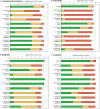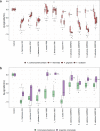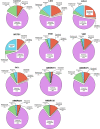Antimicrobial potential of known and novel probiotics on in vitro periodontitis biofilms
- PMID: 36681674
- PMCID: PMC9867767
- DOI: 10.1038/s41522-023-00370-y
Antimicrobial potential of known and novel probiotics on in vitro periodontitis biofilms
Abstract
Several oral diseases are characterized by a shift within the oral microbiome towards a pathogenic, dysbiotic composition. Broad-spectrum antimicrobials are often part of patient care. However, because of the rising antibiotic resistance, alternatives are increasingly desirable. Alternatively, supplying beneficial species through probiotics is increasingly showing favorable results. Unfortunately, these probiotics are rarely evaluated comparatively. In this study, the in vitro effects of three known and three novel Lactobacillus strains, together with four novel Streptococcus salivarius strains were comparatively evaluated for antagonistic effects on proximal agar growth, antimicrobial properties of probiotic supernatant and the probiotic's effects on in vitro periodontal biofilms. Strain-specific effects were observed as differences in efficacy between genera and differences within genera. While some of the Lactobacillus candidates were able to reduce the periodontal pathobiont A. actinomycetemcomitans, the S. salivarius strains were not. However, the S. salivarius strains were more effective against periodontal pathobionts P. intermedia, P. gingivalis, and F. nucleatum. Vexingly, most of the Lactobacillus strains also negatively affected the prevalence of commensal species within the biofilms, while this was lower for S. salivarius strains. Both within lactobacilli and streptococci, some strains showed significantly more inhibition of the pathobionts, indicating the importance of proper strain selection. Additionally, some species showed reductions in non-target species, which can result in unexpected and unexplored effects on the whole microbiome.
© 2023. The Author(s).
Conflict of interest statement
IC is a co-founder and chief scientific officer of YUN NV. Research of LD is currently funded by VLAIO through a Baekeland mandate in collaboration with YUN NV and SL is a member of the scientific advisory board of YUN NV. The other authors report no conflicts of interest related to this study.
Figures




Similar articles
-
A concerted probiotic activity to inhibit periodontitis-associated bacteria.PLoS One. 2021 Mar 5;16(3):e0248308. doi: 10.1371/journal.pone.0248308. eCollection 2021. PLoS One. 2021. PMID: 33667279 Free PMC article.
-
Antagonistic effects of Streptococcus and Lactobacillus probiotics in pharyngeal biofilms.Lett Appl Microbiol. 2019 Apr;68(4):303-312. doi: 10.1111/lam.13133. Epub 2019 Mar 13. Lett Appl Microbiol. 2019. PMID: 30776138
-
Oral lactobacilli in chronic periodontitis and periodontal health: species composition and antimicrobial activity.Oral Microbiol Immunol. 2005 Dec;20(6):354-61. doi: 10.1111/j.1399-302X.2005.00239.x. Oral Microbiol Immunol. 2005. PMID: 16238595
-
What do we know about the mechanisms of action of probiotics on factors involved in the pathogenesis of periodontitis? A scoping review of in vitro studies.Arch Oral Biol. 2021 Sep;129:105196. doi: 10.1016/j.archoralbio.2021.105196. Epub 2021 Jun 10. Arch Oral Biol. 2021. PMID: 34153538
-
Probiotic properties of Lactobacillus salivarius and closely related Lactobacillus species.Future Microbiol. 2010 May;5(5):759-74. doi: 10.2217/fmb.10.35. Future Microbiol. 2010. PMID: 20441548 Review.
Cited by
-
Impact of toothpaste use on the subgingival microbiome: a pilot randomized clinical trial.BMC Oral Health. 2025 May 30;25(1):854. doi: 10.1186/s12903-025-06159-z. BMC Oral Health. 2025. PMID: 40448072 Free PMC article. Clinical Trial.
-
Vibriocidal efficacy of Bifidobacterium bifidum and Lactobacillus acidophilus cell-free supernatants encapsulated in chitosan nanoparticles against multi-drug resistant Vibrio cholerae O1 El Tor.BMC Infect Dis. 2024 Sep 2;24(1):905. doi: 10.1186/s12879-024-09810-2. BMC Infect Dis. 2024. PMID: 39223499 Free PMC article.
-
Oral Biofilm Composition, Dissemination to Keratinocytes, and Inflammatory Attenuation Depend on Probiotic and Synbiotic Strain Specificity.Probiotics Antimicrob Proteins. 2024 Apr 15. doi: 10.1007/s12602-024-10253-z. Online ahead of print. Probiotics Antimicrob Proteins. 2024. PMID: 38619794
-
Growth Conditions Influence Lactobacillus Cell-Free Supernatant Impact on Viability, Biofilm Formation, and Co-Aggregation of the Oral Periodontopathogens Fusobacterium nucleatum and Porphyromonas gingivalis.Biomedicines. 2023 Mar 11;11(3):859. doi: 10.3390/biomedicines11030859. Biomedicines. 2023. PMID: 36979838 Free PMC article.
-
Advanced biomaterials for targeting mature biofilms in periodontitis therapy.Bioact Mater. 2025 Feb 27;48:474-492. doi: 10.1016/j.bioactmat.2025.02.026. eCollection 2025 Jun. Bioact Mater. 2025. PMID: 40093304 Free PMC article. Review.
References
-
- Jepsen S, et al. Prevention and control of dental caries and periodontal diseases at individual and population level: consensus report of group 3 of joint EFP/ORCA workshop on the boundaries between caries and periodontal diseases. J. Clin. Periodontol. 2017;44:S85–S93. doi: 10.1111/jcpe.12687. - DOI - PubMed
-
- Canut-Delgado, N., Giovannoni, M. L. & Chimenos-küstner, E. Are probiotics a possible treatment of periodontitis? Probiotics against periodontal disease: a systematic review. Br. Dent. J. 1–7 (2021). - PubMed
MeSH terms
Substances
Grants and funding
- G091218N/Fonds Wetenschappelijk Onderzoek (Research Foundation Flanders)
- G091218N/Fonds Wetenschappelijk Onderzoek (Research Foundation Flanders)
- G091218N/Fonds Wetenschappelijk Onderzoek (Research Foundation Flanders)
- C24/17/086/KU Leuven (Katholieke Universiteit Leuven)
- C24/17/086/KU Leuven (Katholieke Universiteit Leuven)
- HBC.2020.2873/Agentschap Innoveren en Ondernemen (Flanders Innovation & Entrepreneurship)
- Lacto-Be 26850/EC | EU Framework Programme for Research and Innovation H2020 | H2020 Priority Excellent Science | H2020 European Research Council (H2020 Excellent Science - European Research Council)
- Lacto-Be 26850/EC | EU Framework Programme for Research and Innovation H2020 | H2020 Priority Excellent Science | H2020 European Research Council (H2020 Excellent Science - European Research Council)
LinkOut - more resources
Full Text Sources
Molecular Biology Databases

